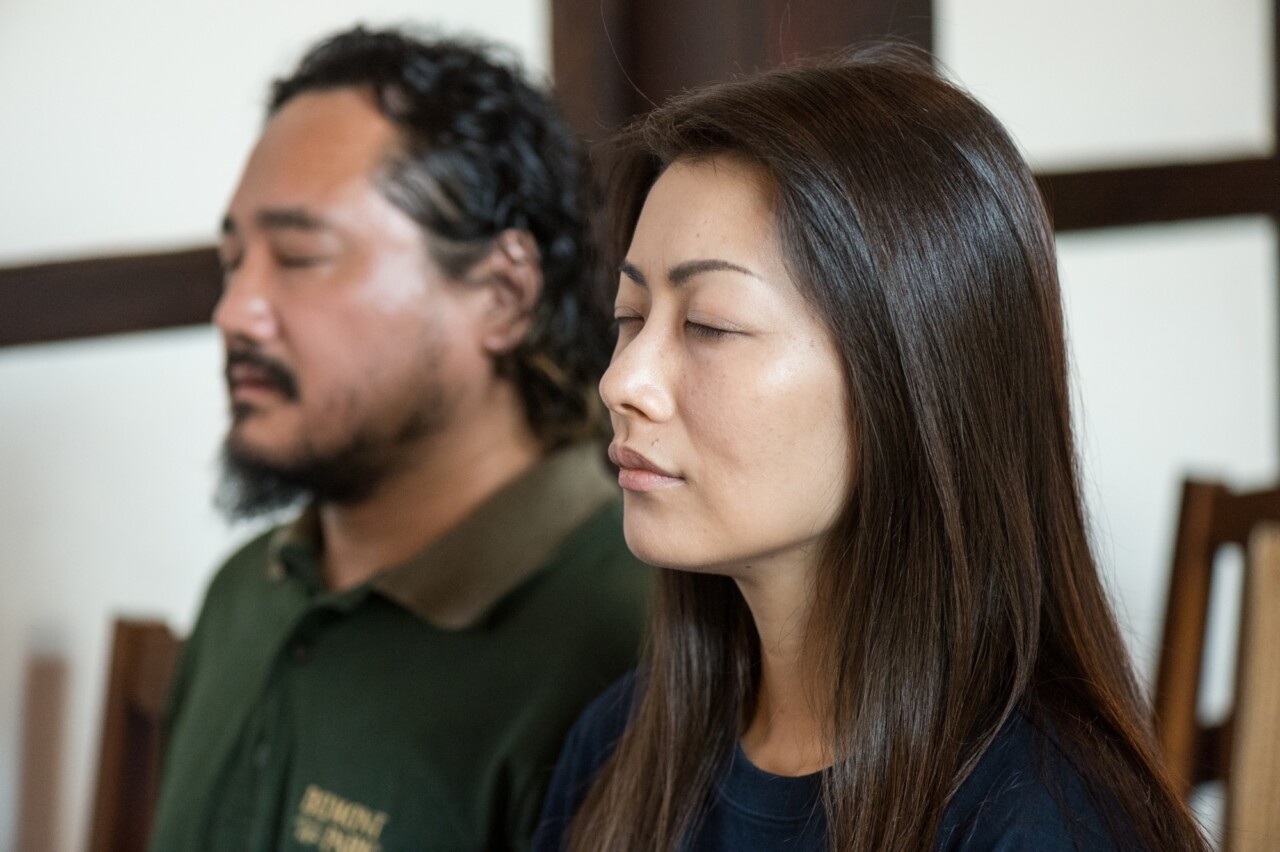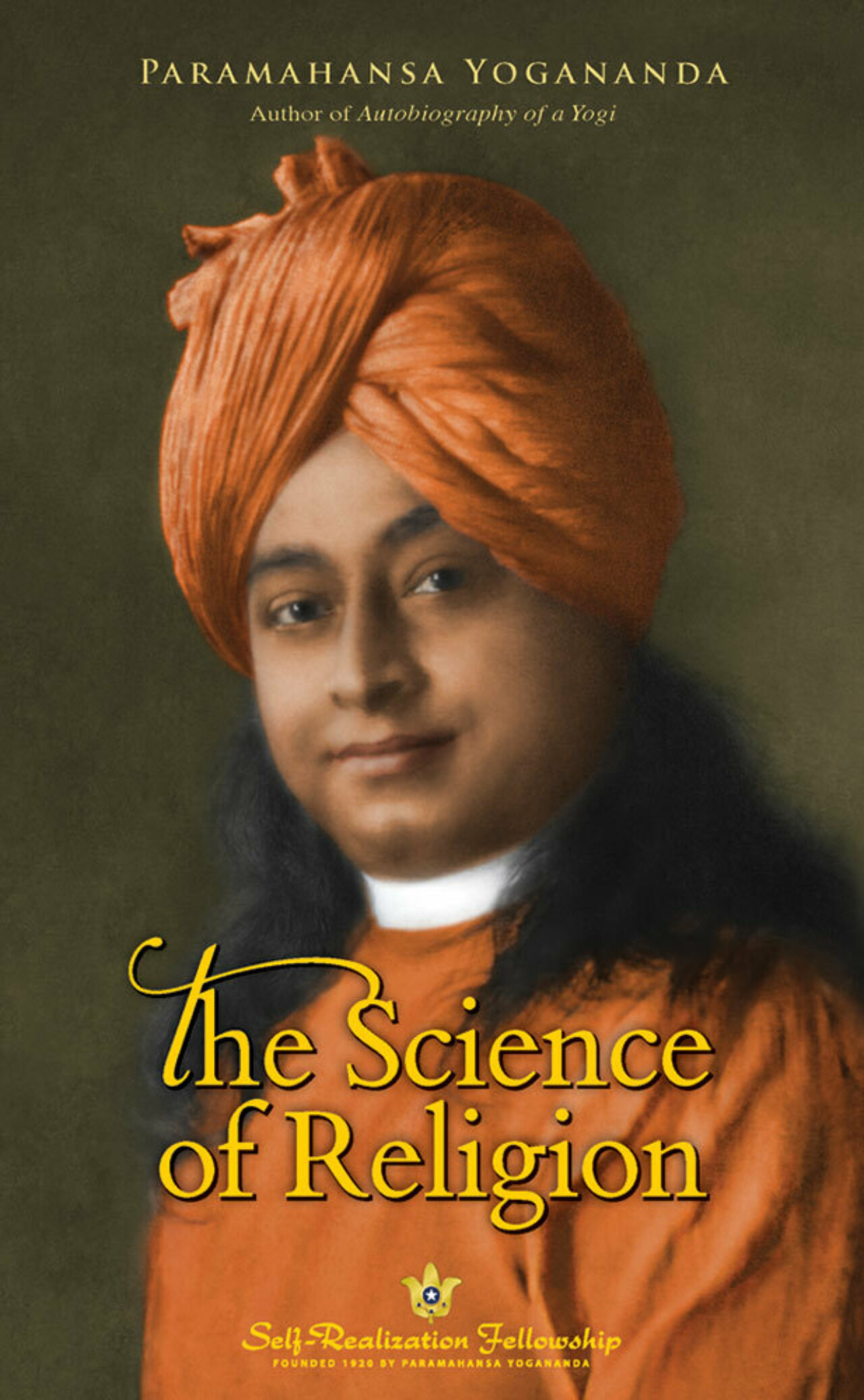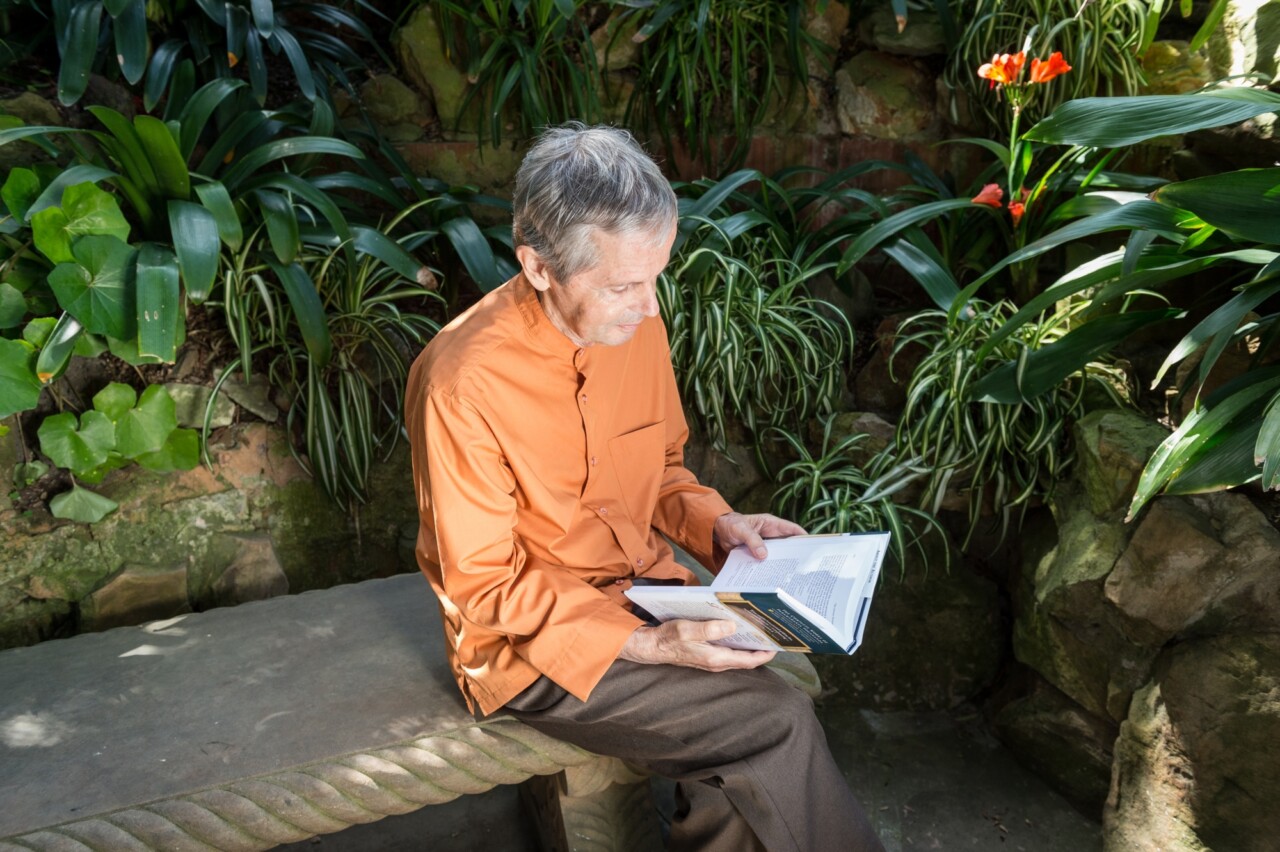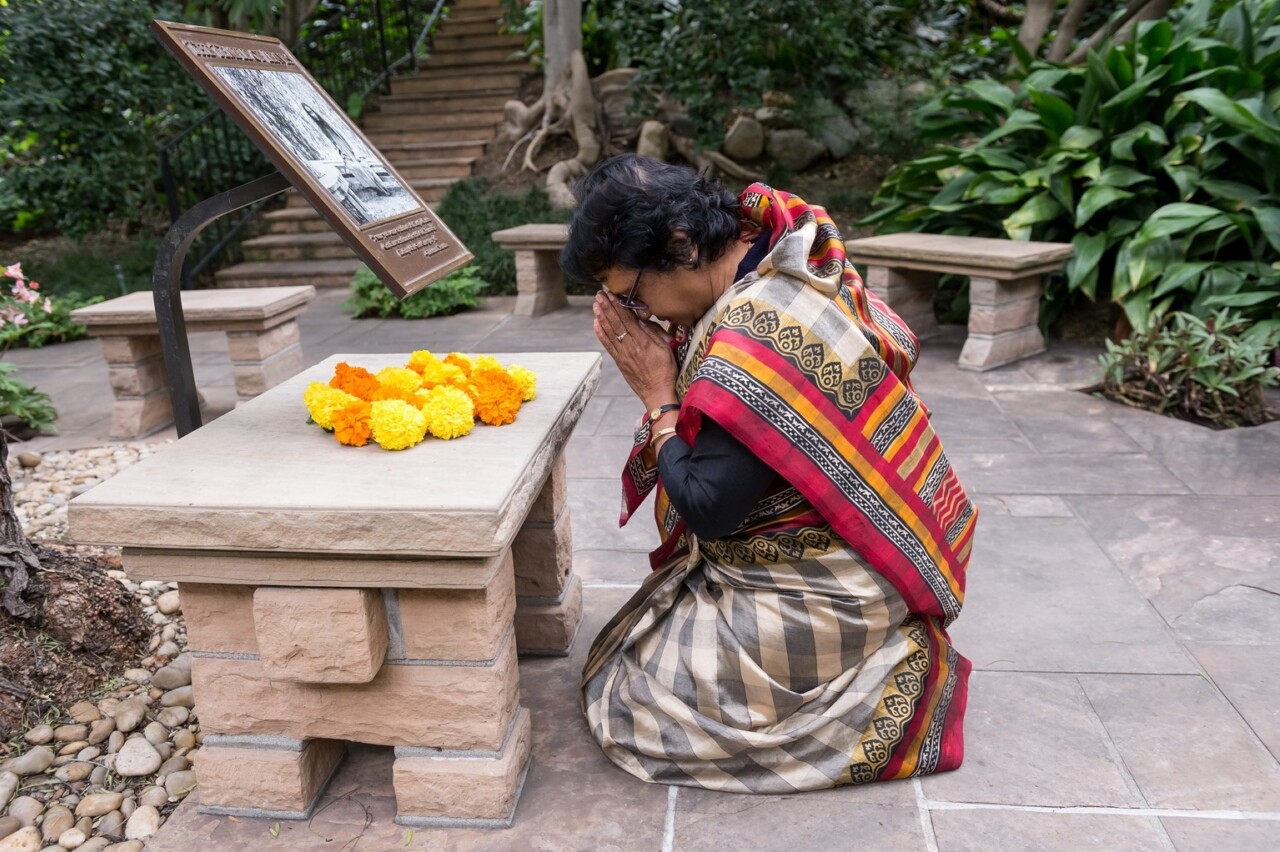

 Donate
Donate
Uniting the soul with Spirit is Yoga — reunion with that great Happiness everyone is seeking. Isn’t this a wonderful definition? In the ever new Bliss of Spirit you are convinced that the joy you feel is greater than any other happiness, and nothing can get you down.
Meditation has been at the heart of India’s philosophy of Yoga since ancient times. Its purpose can be found in the literal meaning of the word yoga: “union” — of our individual consciousness or soul with the infinite, eternal Bliss, or Spirit.
To achieve this union with the blissful consciousness of Spirit — and thus free ourselves from all forms of suffering — requires the patient practice of meditation by following a time-tested and systematic process. That is, we need to apply a science.
Raja (“royal”) Yoga is that complete science of God-realization — the step-by-step methods of meditation and right action prescribed in the scriptures of yoga, which have been handed down for millennia as the essential practices of India’s Sanatana Dharma (“Eternal Religion”). It is this timeless and universal science of yoga which underlies the esoteric teachings at the heart of all true religions.
The Self-Realization Fellowship Raja Yoga teachings outline a way of life leading to perfect unfoldment in body, mind, and soul, based on the foundation of Kriya Yoga, which includes the pranayama (life-force control) technique mentioned but not explicated by Bhagavan Krishna in the Bhagavad Gita and the sage Patanjali in his Yoga Sutras. Lost to humanity at large for many centuries, Kriya Yoga was revived for the modern age by a line of renowned yoga masters: Mahavatar Babaji, Lahiri Mahasaya, Swami Sri Yukteswar, and Paramahansa Yogananda.
Paramahansa Yogananda was chosen by his venerable line of gurus to bring the science of Kriya Yoga to the West and disseminate it worldwide; and it was for this purpose that he established Self-Realization Fellowship in 1920.
Central to the balanced Kriya Yoga path is the daily practice of the scientific meditation techniques taught by Paramahansa Yogananda in the Self-Realization Fellowship Lessons. By practicing meditation we learn how to still the restlessness of the body and mind, so we can experience lasting peace, love, wisdom, and joy as the very nature of our being — no matter what is happening in the world around us.
Meditate more. You do not know how wonderful it is. It is much greater to meditate than to spend hours seeking money or human love or anything else that you can think of. The more you meditate, and the more your mind stays centered in the spiritual state during activity, the more you will be able to smile. I am always there now, in that bliss-consciousness of God. Nothing affects me; whether I am alone or with people, that joy of the Lord is always there. I have retained my smile — but to win it permanently was hard work! The same smiles are there within you; the same joy and bliss of the soul is there. You don't have to acquire them, but rather regain them.
All the experiences I have told you about are scientifically attainable. If you follow the spiritual laws, the result is certain.

Just as a scientist can go into a laboratory to verify the results of a given experiment, so can the yogi go into the “laboratory” of meditation to obtain the same results proven by the rishis of India and by every truth seeker — of any nation, or any time — who has peered into the heart of Reality.
Science does not ask us to accept anything as a matter of blind belief or dogma. By using the definite meditation methods whose results have been demonstrated and replicated by yogi-scientists for countless centuries, we can prove their effectiveness for ourselves — and gradually overcome the false, yet tenacious, idea that we are these limited bodies. Thus we can discover the truth — that as the indwelling Self, the soul, we are untouched by the dualities and the trials of the world; we are and always have been one with the blissful Infinite. Such profound understanding can eventually come to each one who practices right methods of meditation under the guidance of a true guru — one who has fully realized his identity with Spirit.
In this scientific age, when explorations ranging from the vastest expanses to the minutest particles of the physical universe are underway, there is a corresponding need for an equally adventurous and scientific approach to understanding the spiritual realm. We need to advance our spiritual investigations from that of merely discussing beliefs of religion to having the satisfaction of knowing Truth by direct experience. And this same truth should be verifiable by anyone willing to follow the systematic procedures and disciplines that yield such knowledge.
As a spiritual scientist, the yogi practices techniques of meditation to distill the tangible peace, love, wisdom, and joy of divine contact in his or her own consciousness — the only laboratory where the eternal nature of soul and Spirit can be experienced with utter clarity and precision and perfect awe.
In yoga meditation, the meditator withdraws the life force (prana) from the sensory and motor nerves — by a process known as pranayama (life-force control) — and directs it to the higher centers of awareness within the spine and brain. The inwardly retiring prana automatically withdraws the consciousness from the external world to the infinite realm within. Far from being a vague mental process of thinking or philosophical pondering, pranayama meditation is a time-proven way of unlocking the soul’s infinite potential.
Scientists do not make discoveries by prayer alone, but by application of the laws of nature. Similarly, God comes to him who follows the law, who applies the science of meditation. People have wandered in the forest of theology and have lost themselves. In vain I went from temple to temple seeking God; but when I found the soul temples in great lovers of God, I saw that He was there. He is not bribed by beautiful edifices. He comes to the tear-washed altar of the heart that is continuously calling unto Him. God is real. The masters who have devoted themselves to meditation for years and years have found Him.
In all your seeking among different things, directly or indirectly, you are in reality seeking happiness through the fulfillment of your desires.…Then why not seek joy directly?

In his very first lecture in America, and in his book The Science of Religion, Paramahansa Yogananda introduced Westerners to the ancient Vedic concept of God as Sat-Chit-Ananda — ever-existing, ever-conscious, ever-new Bliss.
Beneath our efforts to fulfill all our various desires, is there not a more basic yearning for happiness itself and the corresponding wish to be rid of suffering? Paramahansaji invited those attending his public talks and those who later became students of his Kriya Yoga teachings to find that happiness directly — by using the scientific method of yoga meditation to seek within themselves the bliss of Spirit.
In speaking of the opportunity to know God as Bliss in meditation, Paramahansaji said: “He comes within the calm experience of all. It is in Bliss-consciousness that we realize Him. There can be no other direct proof of His existence. It is in Him as Bliss that our spiritual hopes and aspirations find fulfillment, our devotion and love find an object.”
Joy that rhythmically changes all the time and yet in itself remains unchangeable, like an actor who entertains with different roles and poses, is what all of us are seeking. Such joy can be found only through regular, deep meditation. The inner fountain of unchangeable ever new joy alone can quench our thirst. By its very nature, this divine bliss is the only enchantment that can never tire the mind or make us want to exchange it for something else.

SRF’s president and spiritual head, Brother Chidananda, said while speaking in India in 2017: “India for millennia has been the steward of highest spiritual truth for all humanity. And it was the special dispensation of Paramahansaji to bring the best of India first to the West and then to the world, including back to his beloved India. He reached back to the higher ages, the golden age of India’s high civilization, and brought the essence of India’s universal spirituality in its pure form. That is yoga. It is a science, not a denomination or a sect of religion; and because of that, this spiritual dispensation — the light of yoga — can be a truly worldwide spiritual blessing on humanity as a whole.”
Paramahansa Yogananda often pointed out that one need not be of any specific nationality, race, or religion to practice yoga and receive its sublime benefits. Its true universality as a science lies in the fact that its results can be obtained by anyone of any nation, of East or West.
Through the steady practice of yoga meditation, we all can experience a deepening sense of joy, love, compassion, peace. And as these changes happen within ourselves, their influence also spreads outward, by an unseen law, first to our immediate family and community and then to the world at large. As Paramahansaji said, “Reform yourself and you will reform thousands.”
One great benefit of yoga is that a sense of oneness with all humanity develops in the meditator. Regardless of one’s spiritual beliefs, or lack thereof, whoever practices the science of yoga will eventually realize that the Divine is in everything — and everyone.
Hearts and minds that are imbued with such universality is truly the great need of our times, when our world has shrunk exponentially as a result of technological advances, placing us all at very close quarters. During an interview in 1951, Paramahansaji was asked to summarize his message to the world. He spoke of the fundamental need for humanity to recognize its essential unity — prophetic words that are just as vital today, or even more so, than when he first uttered them:
“My brothers and sisters of the world: Please remember that God is our Father and He is One. We are all His children, and as such we should adopt constructive means to help each other become physically, mentally, financially, and spiritually ideal citizens of a United States of the World. If in a community of one thousand persons each individual tries by graft, fighting, and chicanery to enrich himself at the expense of others, each person will have nine hundred and ninety-nine enemies; whereas, if each person cooperates with the others — physically, mentally, financially, and spiritually — each one will have nine hundred and ninety-nine friends. If all nations helped one another through love, the whole earth would live in peace with ample opportunity for promoting the well-being of all.…
“Such media as radio and television and air travel have brought us all together as never before. We must learn that it can no longer be Asia for Asiatics, Europe for Europeans, America for Americans, and so on, but a United States of the World under God, in which each human being can be an ideal citizen of the globe with every opportunity for fulfillment in body, mind, and soul.
“That would be my message, my plea, to the world.”
The most profoundly impacting “constructive means” for helping one another grow as ideal world citizens in body, mind, and soul can be found in the universal science of yoga.

In his definitive translation and commentary God Talks With Arjuna: The Bhagavad Gita, Paramahansa Yogananda revealed that the Gita, India’s most beloved scripture of yoga, expressed in allegory the entirety of the science of yoga.
The sage Patanjali, who understood fully the Gita’s encapsulation of the message of yoga, organized the essence of the Raja (“royal”) Yoga path into a simple and systematic form in his short but masterly work, the Yoga Sutras.
Paramahansa Yogananda stated that Patanjali “presents, in a series of brief aphorisms, the condensed essence of the exceedingly vast and intricate science of God-union — setting forth the method of uniting the soul with the undifferentiated Spirit in such a beautiful, clear, and concise way that generations of scholars have acknowledged the Yoga Sutras as the foremost ancient work on yoga.”
The yoga system of Patanjali is known as the Eightfold Path, which leads to the final goal of God-realization.
The Eightfold Path of Yoga:
Yama (moral rules outlining the behaviors from which one should abstain): injury to others, untruthfulness, stealing, incontinence (lack of control of the sexual impulse), and covetousness
Niyama (spiritual qualities and conduct to be cultivated): purity of body and mind, contentment in all circumstances, self-discipline, self-study (contemplation), and devotion to God and guru
Asana: right posture
Pranayama: control of prana, the subtle life currents in the body
Pratyahara: interiorization of the consciousness, through withdrawal of the senses from external objects
Dharana: focused concentration; holding the mind to one thought or object
Dhyana: meditation, absorption in the vast perception of God in one of His infinite aspects — Bliss, Peace, Cosmic Light, Cosmic Sound, Love, Wisdom, etc. — all-pervading throughout the whole universe
Samadhi: superconscious experience of union of the individualized soul with Cosmic Spirit
The highest practice of pranayama (life-force control, the fourth step of the Eightfold Path), involves the use of the scientific meditation techniques of Raja Yoga, with the preliminary goal of achieving interiorization of the consciousness (pratyahara), and the ultimate goal of oneness with Spirit (samadhi).
Normally the life force continuously flows outward through the nervous system and senses so that we cognize the world around us. Through techniques of pranayama that same life force (prana) is directed inward toward the higher centers of spiritual awareness in the spine and brain, so that we may perceive the vaster world within us.
The meditation techniques taught by SRF in the Self-Realization Fellowship Lessons, especially the Kriya Yoga technique, are the greatest Raja Yoga pranayama techniques. Paramahansa Yogananda often called them the quickest route to reunite the soul with the bliss of Spirit.
By the practice of pranayama we free the attention from life’s distractions by direct means — controlling the flow of bodily energy that would otherwise keep our consciousness outward. We thereby still the restless thoughts and turbulent emotions that prevent us from knowing our real Self as the unshakeable immortal soul, ever one with Spirit.

Technology is a crucial aid in many aspects of our lives. But as we spend more and more time connected to our various digital devices, we often feel a growing disconnection from inner peace, simplicity, harmony, and a natural sense of awe.
Simply put, technology is just the use of a technique to reach more quickly a desired end. Ideally, its use should enhance our ability to achieve happiness, security, and a deeper understanding of ourselves in relation to the world in which we live.
Humanity’s most advanced technology can be found in the Raja Yoga system, in the use of the techniques of yoga meditation, specifically the techniques of Kriya Yoga.
In his Autobiography of a Yogi, in the chapter “The Science of Kriya Yoga,” Paramahansaji states: “Referring to the sure and methodical efficacy of yoga, Krishna praises the technological yogi in the following words: ‘The yogi is greater than body-disciplining ascetics, greater even than the followers of the path of wisdom (Jnana Yoga), or of the path of action (Karma Yoga); be thou, O disciple Arjuna, a yogi!’”
The “technological yogi” — that is, the truth-seeker who employs definite techniques to attain the goal of yoga — indeed follows a sure method, and one that does not sap the energy and joy out of life, but instead leads to the infinite replenishment and rejuvenation of body and mind through contact with the blissful immortal Self, or soul.
Like Arjuna, Lord Krishna’s ideal disciple in the Bhagavad Gita, we can reach a state of such balance and inner calmness by the use of the technology of Kriya Yoga that we gain the poise and discernment to know how to live in today’s technology-dependent world without losing our natural sense of wholeness and well-being.
The key lies in being, in Paramahansaji’s words, “calmly active and actively calm.” In order to be calmly active in our lives (online and off), we should first become “actively calm” in meditation — and win the wisdom needed to navigate the unpredictable challenges and accelerated pace of our contemporary world.
In Raja Yoga meditation techniques, such as those taught in the Self-Realization Fellowship Lessons, humanity has the most advanced technology in existence, and the way to live a truly victorious life, one filled with ever-new peace and joy, and attainment of our highest potentials.
Open the door of your calmness and let the footsteps of silence gently enter the temple of all your activities. Perform all duties serenely, saturated with peace. Behind the throb of your heart, you shall feel the throb of God’s peace. Fill your heart with the peace of meditation.

Paramahansa Yogananda declared: “Kriya Yoga plus devotion — it works like mathematics; it cannot fail.”
To anyone beginning a practice of yoga and its techniques of meditation, such as those taught on the Kriya Yoga path, SRF points out the necessity of cultivating a deep and enduring relationship with that aspect of the Divine most appealing to their hearts. After all, as Paramahansaji made clear: “There is a personal element in the search for God that is more important than mastery over the whole science of Yoga.” We should follow the yogic science to reach the door to the Infinite, but then our love, our personal longing, is needed for God to take us through that door.
You may like to think of God as the Heavenly Father, or as the Divine Mother, or Friend, or Beloved. Some feel drawn to seeing God as manifest in a true guru or divine incarnation such as Christ or Krishna, or they may gravitate to a more formless aspect such as Infinite Love, Bliss, or Wisdom. Regardless of what image of divinity most moves your heart, seek That wholeheartedly, with the awareness that in devotion to and eventual union with the Divine you will satisfy a longing that nothing else can fulfill.
Paramahansaji said that “God listens to the language of your heart — language that comes from the very depths of your being.” He suggested that after the practice of meditation techniques, and taking time to be absorbed in the stillness which follows, one should speak to the Divine without formality, without pretense — but simply, with the love of one’s heart. You might call to the Cosmic Mother as Her child, saying, “Reveal Thyself, reveal Thyself.” Or you may wish to ask questions of the Divine Intelligence, sincerely seeking guidance about the most pressing issues in your life.
The science of yoga meditation, which is the foundation of Raja Yoga teachings, brings us into direct communion with the Divine. In that state of truest receptivity we then allow ourselves to be spontaneous in what we communicate from the depths of our being — giving voice to our hearts, minds, and souls in an entirely personal way. Naturally, over time, that conversation will transform into the most sublime two-way expression of love. “True devotion,” Paramahansaji said, “is like a plummet that sinks into the sea-bottom of the perception of God.”
In the following words from Paramahansaji, the traveler on the spiritual path can hear a resounding and solacing promise, no matter what aspect of God is most compelling: “In Him you will find all the love of all hearts. You will find completeness. Everything that the world gives you and then takes away, leaving you in pain or disillusionment, you will find in God in a much greater way, and with no aftermath of sorrow.”